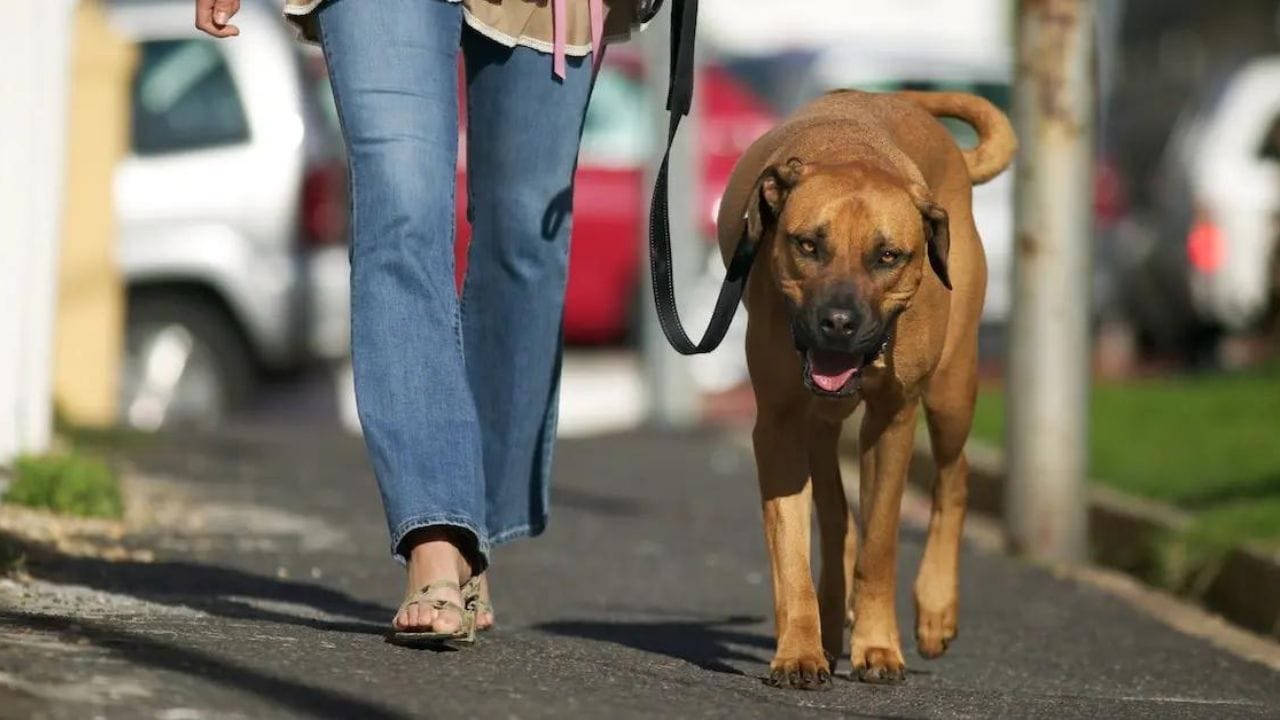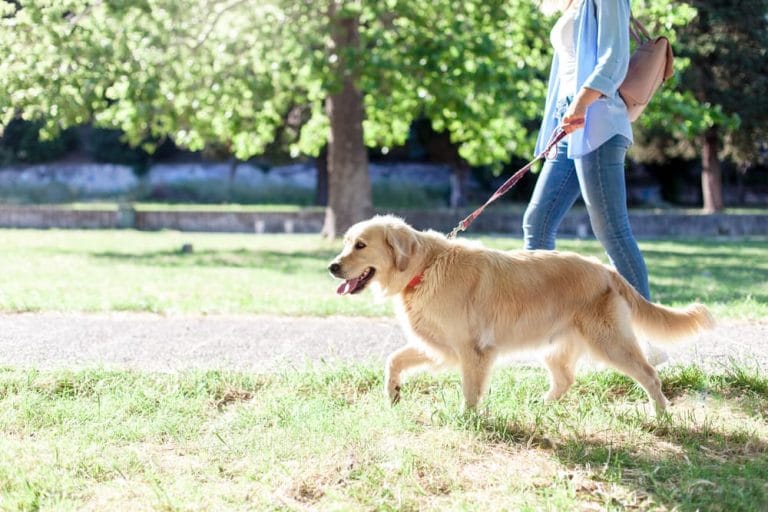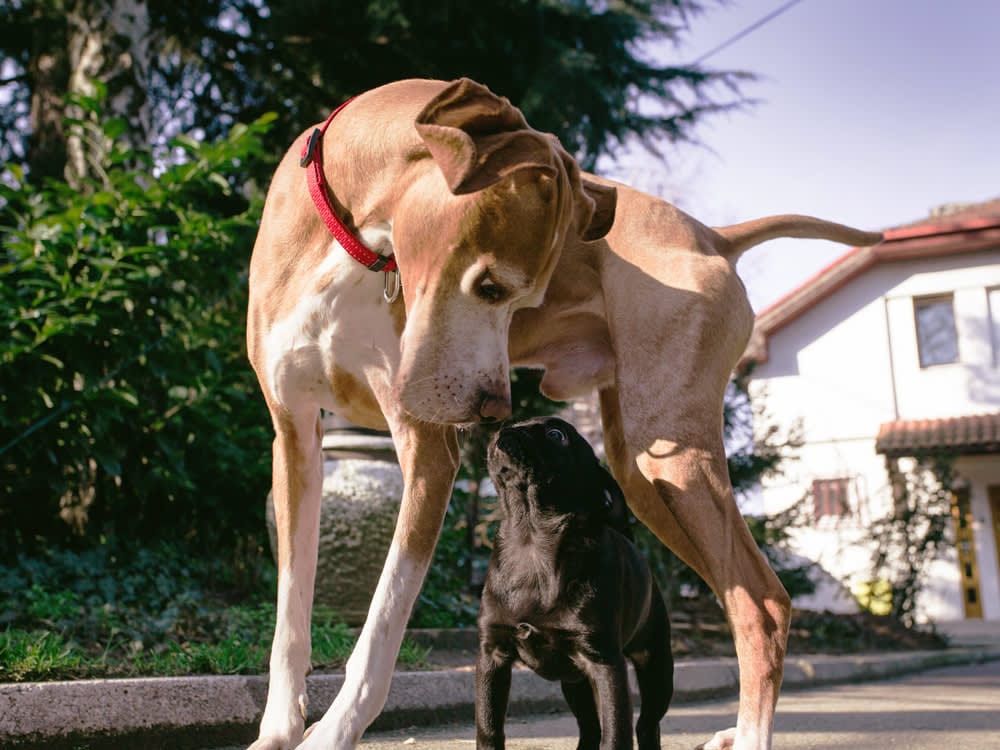How to Walk Bigger Dogs on Dog Walks: Tips and Tricks
Walking a big dog can be a challenge, especially if you're not used to handling larger breeds. It's important to know how to properly walk a big dog to ensure their safety and your own. In this article, we'll provide tips and tricks on how to walk bigger dogs on dog walks.

First and foremost, it's important to have the right equipment. A sturdy leash and collar or harness that fits properly is essential when walking a big dog. It's also important to choose the right leash length - a shorter leash can provide more control, while a longer leash can give your dog more freedom to explore.
Next, it's important to establish good walking habits. Teaching your dog to walk beside you and not pull on the leash can make the experience much more enjoyable for both you and your furry friend. Consistency is key - make sure to reinforce good behavior and correct bad behavior. With the right equipment and training, walking a big dog can be a fun and rewarding experience.
Understanding Your Big Dog
Big dogs require more exercise and mental stimulation than smaller breeds. Understanding your big dog's breed characteristics and behavioral traits is essential to ensure they receive the necessary exercise and mental stimulation during walks.
Breed Characteristics
Breed characteristics play a significant role in determining the type of exercise your big dog needs. For example, some breeds, such as German Shepherds and Great Danes, are prone to hip dysplasia, a condition that affects the hips, making it difficult for them to walk or run. Therefore, it is essential to choose exercises that do not put too much strain on their hips, such as swimming or walking on soft surfaces.
Other breeds, such as Siberian Huskies and Alaskan Malamutes, were bred to pull sleds over long distances and require more vigorous exercise, such as running or hiking, to keep them healthy and happy.
Behavioral Traits
Big dogs can be prone to anxiety and aggression, especially if they do not receive enough mental stimulation and exercise. Walking your big dog in an unfamiliar environment or around other dogs can be stressful for them, leading to aggressive behavior.
To prevent this, it is essential to provide your big dog with enough mental stimulation and exercise before taking them on a walk. Playing fetch or tug-of-war with your big dog before a walk can help reduce their anxiety and prevent aggressive behavior.

In conclusion, understanding your big dog's breed characteristics and behavioral traits is essential to ensure they receive the necessary exercise and mental stimulation during walks. By providing your big dog with the right type of exercise and mental stimulation, you can ensure they remain healthy and happy.
Essential Gear for Walking Big Dogs
Walking big dogs can be a challenging task, especially if you don't have the right gear. The following gear items are essential for walking big dogs safely and comfortably.
Choosing the Right Leash
A sturdy leash is a must-have when walking big dogs. Retractable leashes are not recommended for big dogs as they can easily break or malfunction, putting both the dog and the owner in danger. A standard leash that is at least 6 feet long and made of strong materials such as nylon or leather is the best option.
Selecting a Harness or Collar
Choosing the right harness or collar is important for big dogs, as they can be strong and pull on the leash. Body harnesses are recommended for big dogs as they distribute the pressure evenly across the dog's body, reducing the risk of injury. Head halters can also be effective, but they require proper training and may not be suitable for all dogs.
Additional Walking Accessories
In addition to a leash and harness or collar, there are other accessories that can make walking big dogs more comfortable and enjoyable. Treats can be used as a reward for good behavior, and meats can be used as a high-value treat for training purposes. Carrying gear such as a water bottle and poop bags is also important for long walks.

Overall, choosing the right gear is essential for walking big dogs safely and comfortably. By selecting a sturdy leash, the right harness or collar, and additional walking accessories, owners can ensure that their dogs are happy and healthy on their walks.
Pre-Walk Training and Obedience
Before going on a walk with a bigger dog, it is essential to ensure that the dog is trained and obedient. Pre-walk training helps in preventing any unwanted behavior during the walk. This section covers some of the essential pre-walk training techniques.
Basic Commands and Recall
Basic commands such as sit, stay, come, and heel are essential for obedience training. Recall training is also crucial to ensure that the dog comes back to the owner when called. Positive reinforcement techniques such as treats and praise can be used to reinforce good behavior.
Leash Training Skills
Leash training is essential to prevent the dog from pulling on the leash and to teach them to walk on a loose leash. Pulling on the leash can be dangerous for both the dog and the owner. Positive reinforcement techniques can be used to teach the dog to walk on a loose leash.
In conclusion, pre-walk training and obedience are crucial for walking bigger dogs. Basic commands, recall training, and leash training skills are essential for ensuring a safe and enjoyable walk. Positive reinforcement techniques can be used to reinforce good behavior.
Executing the Walk
Walking a bigger dog requires more effort and control than walking a smaller dog. Here are some tips for executing a successful dog walk with a larger breed:
Handling Distractions
Distractions such as squirrels, birds, and other animals can easily catch a dog's attention and cause them to pull on the leash. To prevent this, it's important to redirect their attention back to the walk. One way to do this is by carrying treats and using them to reward good behavior. Another way is to use verbal cues such as "let's go" or "heel" to get their attention back on the walk.
Maintaining Control and Safety
Maintaining control of a larger dog is crucial for both their safety and the safety of others. One way to do this is by using a sturdy leash and collar that can handle the weight and strength of the dog. It's also important to keep the leash short and close to the body to prevent the dog from pulling or lunging. If the dog does pull, it's important to halt and wait for them to calm down before continuing the walk.
Encountering Other Dogs
Meeting new dogs on a walk can be exciting for some dogs and stressful for others. To handle these encounters, it's important to keep the dog under control and maintain a safe distance from the other dog. If the dog becomes aggressive or overly excited, it's important to calmly handle the situation and redirect their attention back to the walk. It's also important to be aware of other dogs' body language and to avoid any potentially dangerous situations.

By following these tips, walking a bigger dog can be a fun and enjoyable experience for both the dog and their owner.
Post-Walk Routine
After a long walk with a bigger dog, it's important to follow a post-walk routine to ensure their health and well-being. This routine should include a reward and positive reinforcement, as well as a cool down and health check.
Reward and Positive Reinforcement
Rewarding a dog after a walk is an essential part of their training and development. Positive reinforcement, such as giving treats, can help reinforce good behavior and encourage them to continue following commands. It's important to choose healthy treats that are appropriate for their diet and avoid overfeeding.
Cool Down and Health Check
After a walk, it's important to help your dog cool down and check for any signs of health issues. This can include monitoring their breathing and heart rate, checking for any injuries or soreness, and providing water and rest. It's also important to take your dog for a potty break to ensure their comfort and hygiene.
By following a post-walk routine that includes reward and positive reinforcement, as well as a cool down and health check, you can help keep your bigger dog healthy and happy. Remember to always be patient and consistent with your training, and seek professional help if needed.
Advanced Walking Techniques
Training for Heel and No-Pull
Walking bigger dogs can be challenging, especially if they tend to pull or wander off the trail. To make the experience more enjoyable, it's important to train your dog to walk on a leash without pulling. One effective technique is to teach your dog to heel.
To train your dog to heel, start by standing with your dog on your left side. Hold the leash in your right hand with your arm relaxed at your side. Use your left hand to hold a treat in front of your dog's nose. As you start to walk, say "heel" and start moving forward. If your dog tries to pull or wander off, gently pull the leash back and say "no."
Repeat this process until your dog learns to walk calmly at your side. Be patient and consistent, and reward your dog with treats and praise when he does well.
Another technique to prevent pulling is to use a no-pull harness. These harnesses are designed to discourage pulling by gently tightening around the dog's chest when he pulls. This can help your dog learn to walk calmly on a leash without pulling.
Challenges of Walking on Trails
Walking your dog on trails can be a great way to get exercise and enjoy the outdoors, but it can also present some challenges. For example, some trails may be narrow or steep, which can make it difficult to walk with a bigger dog.
To navigate these challenges, it's important to choose the right trail for your dog's size and fitness level. Look for trails that are wide enough for your dog to walk comfortably and avoid trails that are too steep or rocky.
It's also important to bring plenty of water and snacks for your dog, especially on longer hikes. Make sure your dog is well-hydrated and take breaks as needed to rest and recharge.

By using these advanced walking techniques and taking the challenges of walking on trails into consideration, you can ensure that your dog gets the exercise he needs while enjoying the great outdoors.
Frequently Asked Questions
What techniques can be used to prevent a large dog from pulling on the leash?
One effective technique is to use a front-clip harness that will give you more control over the dog's movements. You can also use a head halter or a no-pull harness to discourage pulling. Consistent and positive reinforcement training can also help to teach your dog to walk calmly on a leash.
How can an owner manage a dog that is physically stronger during walks?
Owners can use a sturdy leash and a harness to manage their dog's strength. They can also use a hands-free leash to keep their hands free while walking. Additionally, owners can train their dogs to respond to commands such as "stop" or "heel" to help manage their dog's strength.
What are effective methods for training large breed dogs to walk nicely on a leash?
Positive reinforcement training is the most effective method for training large breed dogs to walk nicely on a leash. Owners can use treats, toys, and praise to reward their dog for walking calmly on a leash. Consistency and patience are key when training a large breed dog.
What strategies can be employed to control a big dog on walks?
Owners can use a variety of strategies to control a big dog on walks. They can use a shorter leash to keep their dog close, or a longer leash to give their dog more freedom. Owners can also use a head halter or a no-pull harness to discourage pulling. Consistent training and positive reinforcement can also help to control a big dog on walks.
Can you give tips for walking two dogs at once, especially if they are of different sizes?
Owners can use a double leash or a coupler to walk two dogs at once. They should choose a leash that is appropriate for the size and strength of both dogs. Owners should also be aware of their surroundings and keep their dogs under control at all times.
Should the duration of walks be adjusted based on the size of the dog?
Yes, the duration of walks should be adjusted based on the size of the dog. Smaller dogs may not need as much exercise as larger dogs, so owners should adjust the duration of walks accordingly. Owners should also be aware of their dog's physical limitations and adjust the duration of walks accordingly.




